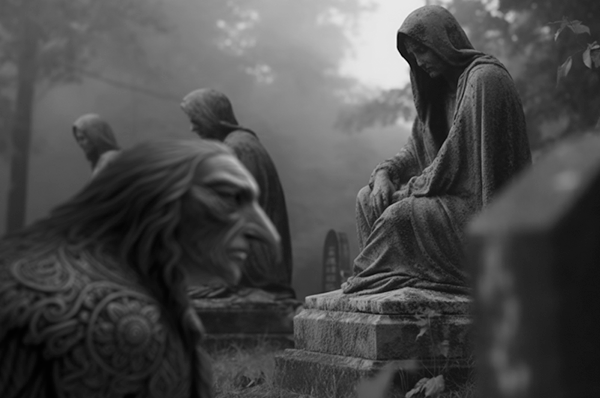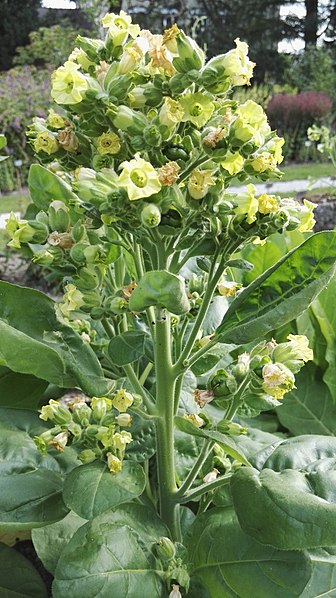In the mythological traditions of the Cherokee people, tales of mysterious beings known as Raven Mockers (Kâ’lanû Ahkyeli’skï or Kalona) evoke fear and fascination. Described by James Mooney in his historical accounts, a Raven Mocker (imitator) is among the most feared figures in Cherokee lore, believed to possess the ability to steal the life force of the dying.
These supernatural entities, portrayed as withered and aged figures, take to the skies at night in a fiery form with outstretched arms resembling wings. Their presence is heralded by a distinctive cry akin to a raven’s call, signaling impending death to those who hear it.
“At night, when someone is sick or dying in the settlement, the Raven Mocker goes to the place to take the life. He flies through the air in fiery shape, with arms outstretched like wings, and sparks trailing behind, and a rushing sound like the noise of a strong wind. Every little while as he flies he makes a cry like the cry of a raven when it “dives” in the air–not like the common raven cry–and those who hear are afraid, because they know that some man’s life will soon go out.”

According to tradition, Raven Mockers gather at the homes of the sick and dying, invisible to all except those with special medicine or knowledge. Without intervention by a skilled medicine man, these malevolent beings torment and ultimately kill their victims, consuming their hearts to extend their own lives.
“Sometimes to do this they even lift him from the bed and throw him on the floor, but his friends who are with him think he is only struggling for breath.”
Though it is sometimes referred to as a witch, that is a European term. The Cherokee call evil spirits that torment the sick Sunnayi Edahi, or “the Night Goers.” They cannot be seen except by certain medicine men. Then they may look like a person, or take the form of an animal.
Imagine how terrifying, to be deathly sick and yet have to worry about this! The family will summon a medicine man to keep watch and hold it away until the person recovers. If the person dies, the medicine man will keep watch until the person is buried. After burial the heart cannot be taken.
The medicine man drives a sharpened stick into the ground at each corner of the house. Then, about noontime he gets ready the Tsâl-agayû’nlï or “Ancient Tobacco”, (reborn or remade – sacred tobacco) with which he fills his pipe, repeating the chant below. He then wraps the pipe in a black cloth. He then goes out into the forest, and returns just before dark, about which time the evil spirit will arrive. Lighting his pipe, he goes slowly around the house, puffing the smoke in the direction of every trail by which the Kalona might approach. He then goes into the house to wait. When the spirit arrives, the sharpened stick on that side of the house shoots up into the air and comes down like an arrow upon his head. This causes the spirit to die within seven days. Family and friends check near and far for someone who dies within that time, knowing they were the Night Goer.
Mooney recounts stories of brave individuals like Gûñskäli’skï, equipped with the right medicine, who hunted and confronted Raven Mockers, ensuring protection for the vulnerable. It was believed that when a Raven Mocker was identified and its true form recognized, its demise was inevitable within seven days.
In one chilling narrative shared by Mooney, a young man seeking shelter inadvertently encounters Raven Mockers disguised as an elderly couple. Hidden in darkness, he witnesses their gruesome ritual of roasting a heart over the fire. The sinister exchange between the couple reveals their macabre intentions, reinforcing the malevolent nature of these mythical beings.
The story takes a grim turn as the young man narrowly escapes, carrying with him the harrowing secret of the Raven Mockers’ true identity. Returning with a group of warriors, they discover the charred remains of the Raven Mockers, their earthly form destroyed.
The mythology of the Raven Mockers highlights the Cherokee belief in supernatural forces that govern life and death. Witches are believed by some to transform into great horned owls. This transformation, influenced by Anglo culture, has been inaccurately labeled with the English term “shapeshifter.” The Cherokee term for witch and great horned owl are the same (Tsgili) “tsi-s-gi-li” ᏥᏍᎩᎵ.
Chant:
The chant below against this spirit is from a Cherokee Medicine man named Ayuninis, collected and published in 1891. He calls upon two spirits to help him fight the evil one. They are the Red Man and the Purple Man. Red Man is the spirit of power, triumph, and success. Purple Man brings trouble, vexation and defeat.
Sgë! Uhyûntsâ’yï galûnlti’tla tsûltâ’histï, Hïsgaya Gigage’ï, usïnu’lï di’tsakûnï’ denatlûnhi’sani’ga, Uy-igawa’stï duda’ntï. Nûnnâ’hï tatuna’watï. Usïnu’lï duda’ntâ dani’yûnstanilï’.
Sgë! Uhyûntlâ’yï galûnlti’tla tsûltâ’histï, Hïsga’ya Të’halu, hinaw?sü’?ki. Ha-usïnu’lï nâ’gwa di’tsakûnï’ denatlûnhisani’ga uy-igawa’stï duda’ntï. Nûnnâ’hï tätuna’wätï. Usïnu’lï duda’ntâ dani’galïstanï’.
Translation:
Listen! In the Frigid Land you repose, O Red Man, quickly we two have prepared arrows for the soul of the Imprecator (one who invokes evil). He has them lying along the path. Quickly the two of us will take his soul as we go along.
Listen! In the Frigid Land you repose, O Purple Man, quickly now we two have prepared your arrows for the soul of the Imprecator. He has them lying along the path. Quickly we two will cut his soul in two.
Notes on Medicine Men and conjuring:
Though the Kalona is sometimes referred to as a witch, that is a European term. The Cherokee call evil spirits that torment the sick Sunnayi Edahi, or “the Night Goers.” The Night Goers cannot be seen except by certain medicine men. Then they may look like a person, or take the form of an animal.
In addition to magical procedures to ensure protection in a specific circumstance—such as when going to war, when traveling, or when attending a gathering of people among whom there might be personal foes—the Cherokees know and practice measures for the guarding of an individual against an unknown enemy or an unforeseen danger.
There are texts of incantations used for the general purpose of protection. They are, generally (possibly invariably), either “going to water” or tobacco preparation texts. It’s known that laypeople are familiar with and use simpler incantation texts, especially those related to water rituals, but the more complex and potent texts belong exclusively to the medicine men and women.
These professionals rely heavily on these texts, using them not only for clients’ benefit but also for self-protection, as they are often targeted by malevolent magical practitioners.
During a tobacco preparation ceremony, the practitioner announces their name and clan or, if the tobacco is intended for a client, the client’s name and clan. In certain rituals, after preparation, the tobacco is held outstretched towards the rising sun before being slowly brought down across the face of the sun. According to Western Cherokee beliefs, this exposure to the sun’s rays enhances the tobacco’s power, although its primary authority comes from the incantation.
Tobacco treated with specific incantations can be stored for later use in situations like sudden unease or unexplained physical discomfort, which could indicate sorcery from an unknown source. General-purpose “protection” tobacco can also safeguard a vacant house or an ill person who is particularly susceptible to witchcraft due to their weakened state.
To maintain the potency of stored “remade” tobacco, precautions must be taken to protect it from “breaking,” which can occur in the presence of a pregnant or menstruating woman, a corpse, or someone who has been in contact with a corpse without purification.

Nicotiana rustica L. , or wild tobacco is a nightshade family shrub containing several times the nicotine of typical tobacco. It is sometimes an ingrediant in substances ingested to produce a non-ordinary state of consciousness for spiritual purposes.
